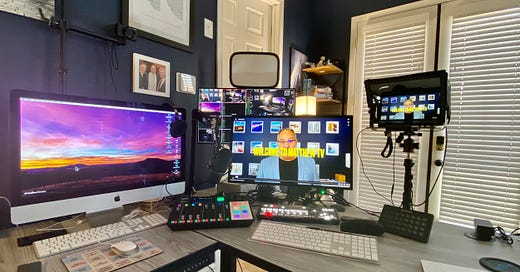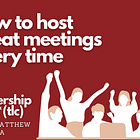Twenty Tips for Better Online Meetings
A bunch of best tips for making your online leadership even better
This week, let’s talk online meetings. By now we’re all Zoom aficionados — but there’s always room for improvement. Plus a review of some essential presentation techniques always helps us deliver experiences worth attending. So here are twenty of my favorite tips — plus two PDFs you can print for quick reference every day. Enjoy!
If you’re not a full-subscription member of TLC, why not give it a try! Four full weeks of access and Monday Coaching Calls for free if you click this button below.
Ten Tips for Better Virtual Presentations
Stand up and let your voice and breath flow stronger during your virtual presentations - plus leverage your natural body language. Use a standing desk (I have an Uplift desk and it’s fantastic!)
Improve the light and camera clarity by facing a window or adding more artificial light in front of you (and less behind you).
Use a better microphone like Sure MV5 USB-mic, or broadcast-quality podcast microphone and soundboard to improve the sound, reduce echo and eliminate feedback. I use a Rodecaster and a Sure MV7 mic for a powerful presence.
Start with small talk. Allocate plenty of time for rapport building, even in a virtual environment. Get people comfortable and engaged before they learn.
Use virtual tools like chatroom, annotation/drawing tools, polling and whiteboards to create a “physical” interaction with your audience.
Slow down your pace. In a virtual environment, participants take longer to process information - plus technology hiccups and distractions interrupt the normal speed of conversation. Give people plenty of time to think and keep up.
Ask more questions than usual to keep the audience in flow with your presentation and minimize the temptation to multitask in the background.
Use more multimedia interactivity - such as video clips, shared webpages and game-like activities. Even collaborating in a spreadsheet or document offers participants a role in co-creating content and guiding the discussion.
Send materials in advance by digital download (or even printed by mail). Handouts, props, books, brochures and other physical materials bridge the virtual gap for some learners.
Provide an edited transcript with "cue points" related to the recording after each presentation. Help the audience “find” important parts of the discussion and reinforce understanding by reading, watching and listening again.
Do you have a favorite presentation tip? I’d love to include it on this post - just add it to the comments below! ⬇️
Ten MORE Virtual Presentation Tips to Improve Your Online Sessions
After years of teaching online, I’ve got even more tips and tricks I’ve learned, especially as the technology has continued to improve. So, here are ten additional favorites for our upgraded subscribers and downloadable lists. 👇👇
Know the Audience. Review your attendance list in advance and write down a need, concern or goal next to each participant's name. Target your message to each person’s specific, relevant concerns.
Tailor your Content. Account for the audience's needs, time and technical challenges so that your message is exactly what they need. Modify the quantity, speed and depth of your materials to suit the time/group at hand.
Cover the four key learning needs of every participant: WHY, WHAT, HOW, WHAT-IF. No matter how many participants, there will be something for everyone if your message addresses each of these key learning requirements. You don’t have to spend a lot of time on everyone, but touching on all four increases the reach of your message.
Keep a list of "follow-ups" you commit to providing after the session. Summarize your take-aways at the end and set expectations for when participants will receive them. A good AI assistant can also keep notes of your take-aways, and is often built in (Zoom added this feature recently which emails you within minutes of closing your session.)
Tell Lots of Stories. Highlight key points, features and benefits of your content by telling a story of someone who has been successful using them.
Smile lots and have fun! When your audience sees how much you enjoy sharing your content, they will catch the energy and connect better.
Use open-ended questions. Go beyond yes/no/thumbs-up interactions and invite participants to give specifics by talking to you or typing in the chat room. Reach the chat contributions, too, to validate you’re seeing and appreciate them.
Share files and links. During the program, transfer a PDF, video or spreadsheet via the chat, as well as sharing hyperlinks for participants to bookmark and check out after the session.
Involve Peers. Find ways to get your colleagues involved with a quick points, comment or examples. A brief cameo appearance, panel or even a pre-recording can make online sessions more than a lecture.
Be patient. It takes time for participants to absorb a message, then formulate questions or comments. Give them plenty of time when you ask for input. You'll be rewarded with a more meaningful conversation and learning experience.
Here are two PDFs to help you remember all TWENTY TIPS. Print them out and keep them handy.
See you Monday on our next TLC Coaching Call!
— M








